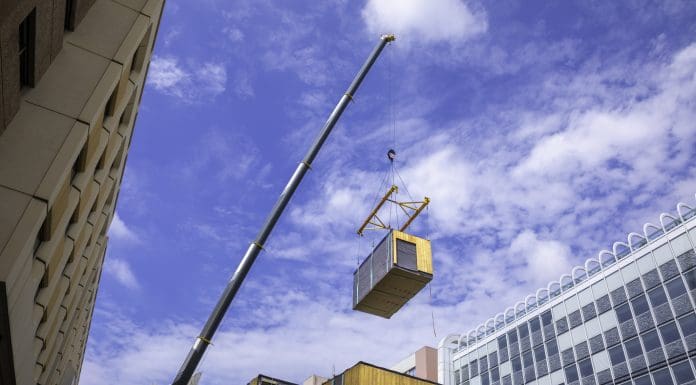
Denise Tuffy of the Smart Offsite Association on the promise – and precarity – of Ireland’s offsite manufacturing sector
As the pressure intensifies to accelerate housing and infrastructure delivery, Ireland’s off-site manufacturers are ready. But readiness without demand is a missed opportunity.
Ireland correspondent Carol Tallon sat down with Denise Tuffy, director of specialist contracting at the Construction Industry Federation (CIF) and lead for the Smart Off-site
Association (SOsA), to discuss how government strategy, procurement reform and industry coordination can move offsite construction from policy ambition to delivery reality.
What is SOsA and what role does the organisation play in Ireland’s construction ecosystem?
Denise Tuffy (DT): SOsA was established within CIF to represent Ireland’s factory-based offsite manufacturers. These are firms delivering certified, high-quality buildings across 3D volumetric systems, timber frame, CLT, SIPs and hybrid methods.
We engage across education, health, housing and commercial sectors. Our members include Vision Built, Actavo, Cygnum, CPAC, GFrame, MMC Homes, Castle Group, Manley Timber Frame, Adston, Lidan Designs and ExtraSpace. Each brings deep technical capability, delivery capacity and –critically – regional employment.
My role is to coordinate the sector’s voice on certification, standards, procurement and pipeline visibility to ensure industry-informed policy.
We set up SOsA because too often, even though manufacturers were delivering on major public and private sector projects, they were not represented in key policy forums. We needed to address that gap – and now the Smart Offsite Association, through our members, is doing that.
SOsA members published a capacity survey earlier this year, what did it reveal about the sector’s current state?
DT: The findings were stark. Ireland’s volumetric manufacturers are operating at just 48% capacity. That’s a huge underutilisation of national capability.
These firms could deliver 1,178 housing units annually, but just 314 were delivered in 2023. We asked our members to estimate what they could deliver by the end of 2025, and most expect that volume to fall further if the current demand pattern continues.
On the employment side, the 2024 Capacity Survey recorded 409 employees across respondent factories, with headroom to expand by a further 39% if production demand improved. These are high-quality regional jobs, many in areas where manufacturing opportunities are limited.
All of our volumetric members reported a decline in orders compared to 2023, and more than half expect that trend to continue. More worryingly, every single manufacturer indicated they have either already begun or are actively considering pivoting to export markets to keep factories viable. We cannot afford to lose this capacity abroad.
Following publication of the Modern Methods of Construction Action Plan by the Irish government in June 2025, Budget 2026 further resourced MMC. How meaningful is this?
DT: It was a step forward. Minister Donohoe confirmed funding to advance the National Demonstration Park for Modern Methods of Construction, which is a flagship commitment under the Modern Methods of Construction Action Plan, published in June 2025. That plan, developed in collaboration with industry and education partners, outlines 58 specific actions to modernise the sector. These include commitments around skills development, regulation, innovation and procurement.
The Demonstration Park is important because it will showcase certified systems and allow public sector decision-makers to see what modern offsite solutions look like.
But ultimately, it’s just one piece of the puzzle. Manufacturers need stable, multi-year procurement pipelines. Without volume, even the best demonstrations won’t convert into jobs or homes.
Which sectors have shown most promise for offsite delivery?
DT: Education has been the standout so far. The Department of Education has a national framework for offsite delivery of school buildings. It is not perfect but it offers continuity and repeatability, which is exactly what our factories need.
We have seen positive outcomes. For example, CPAC Modular delivered Kishoge Community College in Dublin, a large-scale post-primary facility. Similarly, ProCon Modular recently completed the new Gaelscoil Lir and the Goatstown post-primary school – all using volumetric modular methods. Projects like these prove what is possible when you align design, procurement and delivery from the start.
Healthcare should be next. Hospitals are live environments where speed and minimal disruption are critical. Modular systems are ideal here. We know that the HSE is exploring this, and we are engaging actively. But again, what we need is structured access to that pipeline, not just one-off pilots.
We are also seeing traction in the private sector – across cost-rental, student accommodation and logistics facilities – where time-to-market matters. But to scale and sustain this capability in Ireland, we need more consistent public sector engagement.
Certification is often cited as a challenge or barrier for industry innovators; what’s the status across SOsA members?
DT: Most SOsA members hold or are pursuing NSAI Agrément Certification, which is critical for system approval under Irish Building Regulations. Many also maintain ISO
9001 (Quality), ISO 14001 (Environmental), ISO 45001 (Health & Safety), and for UK exports, BOPAS (Buildoffsite Property Assurance Scheme).
These systems are robust and necessary. However, the path to certification can be long, expensive and uncertain, especially for firms with non-standard or hybrid systems. One of the reasons we established technical working groups within SOsA was to support members through that process and to engage with NSAI and the Department of Housing on streamlining where appropriate.
We also have concerns about emerging planning exemptions for temporary structures. While well-intentioned, if they permit uncertified or poorly regulated modular units, it could undermine the standards that established manufacturers have invested in. We want high standards; but we also want fair, proportionate and efficient routes to compliance.
Where is the biggest policy disconnect right now?
DT: The number one issue is pipeline. Without predictable, multi-annual public sector contracts, manufacturers cannot invest with confidence. Our survey showed that inconsistent procurement is the single greatest barrier to growth across the sector.
SOsA members are calling for multi-annual frameworks that span social housing, education and healthcare. These frameworks should be MMC-specific or MMC-enabling, with clear timelines and volume commitments.
The second issue is procurement reform. At the moment, most public sector tenders still default to lowest cost, which simply does not reflect the value that MMC brings in terms of quality, speed, safety and sustainability. Certainty of programme is a key priority for both public and private sector project owners. We want to see value-based procurement and clearer evaluation criteria for MMC systems.
Finally, there is a pressing need to define and adopt a national methodology for Pre-Manufactured Value (PMV). If we’re going to set MMC targets – such as the 25% target in social housing delivery under Housing for All – we need to be able to measure that consistently across projects and systems.
From your dialogues with government, is there a willingness to shift procurement?
DT: There is certainly recognition of the need. The MMC Action Plan is a positive step and initiatives like Construct Innovate are building the research base. But implementation is the challenge.
In our ongoing conversations with policy and delivery teams, we are emphasising the need for blended delivery – that means housing, healthcare, education and other public sector bodies working together to provide cross-sector volume that keeps factories going.
Also, we have made practical suggestions: pre-qualified panels, forward funding options for manufacturers and incentives for contracting authorities to include MMC early in the project lifecycle. If MMC is only considered at the end, it will never shape the process and that would be a huge missed opportunity.
What’s next for SOsA?
DT: Growth, consolidation and influence. SOsA is bringing together firms across all MMC typologies and we are making sure their voices are heard at national and regional level.
We are also developing shared resources – technical groups, R&D partnerships and policy submissions – to make sure our members are supported and that the value of offsite is clearly communicated to all stakeholders.
To policymakers, our message is clear: your modular sector is here, capable, and underused. And to manufacturers: if you’re building smarter, cleaner and faster, SOsA is your home.
The post Ireland’s offsite manufacturing sector: “We have capacity. What our members need now is a robust and reliable pipeline.” appeared first on Planning, Building & Construction Today.

